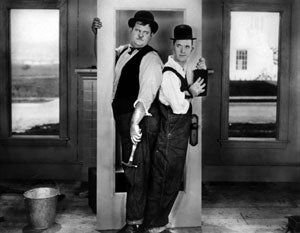Last weekend, Turner Classic Movies staged their 3rd annual TCM Classic Film Festival in Los Angeles. As a part of the program, UCLA Film & Television Archive screened three Laurel & Hardy shorts, which were recently preserved by the Archive: Busy Bodies (1933), County Hospital (1932) and Helpmates (1932). We had a full house, but I was shocked when Jeff Joseph, who provided a major donation to kickoff the Laurel & Hardy Preservation project, asked the audience whether they had ever seen a Laurel & Hardy film on the big screen, and about 90% said they hadn’t. So for us, it was really worthwhile being at TCM, because we introduced so many people to a big screen Laurel & Hardy experience. But getting the films to the screen was challenging indeed!
"The Archive’s holdings, in fact, constitute the largest number of original Laurel & Hardy negatives in the world."
This project began a little more than a year ago, when Jeff Joseph, the founder of SabuCat, approached the Archive with a proposal to preserve all the remaining Laurel & Hardy films since UCLA is the caretaker for all the original surviving nitrate materials, whether print or pre-print, from the Hal Roach estate now owned by a well-known maker of birthday cards. The Archive’s holdings, in fact, constitute the largest number of original Laurel & Hardy negatives in the world. However, due to their incredible popularity, Laurel & Hardy prints and negatives have been continually cut and rereleased, leading to a plethora of materials in existence, virtually none of them complete or authentic. Given the damaged state of the Laurel & Hardy legacy, and the existence of so many original negatives at UCLA, the Archive decided to take up Mr. Joseph’s great challenge.

To kick off the fundraising campaign, the Archive screened two seldom seen Spanish language versions of Laurel & Hardy films, Politiquerias (1930) and La Vida Nocturna (1930), at our UCLA Festival of Preservation in March 2011. Simultaneously, we launched our Laurel & Hardy webpage and an online fundraising campaign dedicated to restoring these Laurel & Hardy materials. To date, the Archive has received donations and pledges in excess of $175,000; some of it coming from the many Sons of the Desert tents around the world, some from TCM, the remainder from Joseph and another major donor. While this sounds like a lot of money, it will probably only allow us to restore about eight or nine short titles.

Completing restoration work on three titles for this year’s TCM festival was another matter. Initially, we applied for and received a grant from the Myra Reinhard Family Foundation to assess the collection. The first stage of restoration, then, involved the inspection of nitrate film, writing detailed condition reports and completing cataloging records on the Laurel & Hardy titles. Once the Archive’s internal processing has been completed (the survey is presently about half-done) and we understand not only what pre-print materials are held within our own collection, but also what condition they are in, we can move forward with the long term restoration plan of identifying print sources found in other archives, determining best material available, supplementing missing material and actively begin the preservation and restoration process.
"To date, the Archive has received donations and pledges in excess of $175,000....While this sounds like a lot of money, it will probably only allow us to restore about eight or nine short titles."
But while that work was going on, we needed to identify three titles do work on immediately. Because one of our funders wished the restoration work to be done digitally, we contracted with a postproduction house to work with the Archive to digitally scan and clean up a single short title, Scram! (1932). However, ten months later, we had still not received satisfactory results, due to the many problems still associated with digital restoration work. Happily, we were able to replace that title with Helpmates, which we had preserved a few years ago.
Meanwhile, preservationist Jere Guldin completed analog film restoration on County Hospital and Busy Bodies, which were relatively unproblematic from a restoration point of view. The new prints looked gorgeous, so beautiful that we believe digital restoration would be superfluous. And that is the big question for us, do we spend a certain amount on analog restoration or more than twice as much money on digital work? In many cases, where the original materials are in poor condition, we will have to take the latter option. But it won’t be cheap, so make a donation!






 Mobile Navigation
Mobile Navigation

